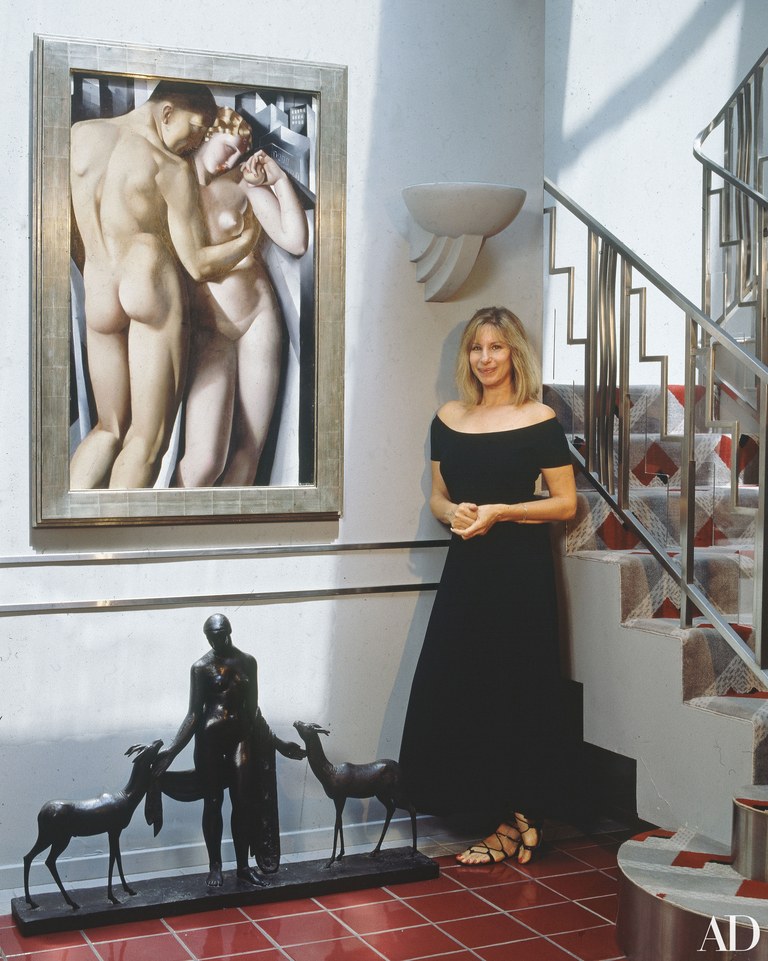So she studied the many books and portfolios that she had gathered on the period, such as Le Luminaire, a portfolio of lighting designs that was published to coincide with the watershed Exposition Internationale des Arts Décoratifs et Industriels Modernes, held in Paris in 1925. She pored over illustrations of decorative motifs, eventually designing several for the house’s architectural details—doors, friezes, and stair rails, ceramic tile patterns, rugs, and even a shower curtain in one of the baths.
The living room fireplace is embellished with a Mondrian-like arrangement of stainless-steel decorative panels that were part of the landmark Art Deco Richfield Building in downtown Los Angeles. The bedroom carpeting was copied from a 1930s Bigelow original that Streisand recalled seeing in the Huntington Hotel in San Francisco. Where original furnishings weren’t used, she had reproductions or interpretations made.
Given that she designed a necklace to harmonize with the house, it’s no wonder that she admires architects like Frank Lloyd Wright, whose approach to design often stretched beyond the house and the furniture in it to dresses for his women clients to wear at home. “If you were an architect,” Streisand argues, “wouldn’t you want to design the bronze handles? Wouldn’t you want to design the floors? Wouldn’t you want to design the furniture that goes into the house you built? That’s the way I see things—as a complete vision.”
Another area in which Streisand set strict limits for herself was that of color. Unable to decide between gray and burgundy for the house’s exterior, she used both—the house is gray on two sides, burgundy on two sides. These colors formed the basis for the interiors, which consist of only two color ranges: black to gray, and burgundy to pale rose. Each room in the house is decorated in a different combination of these two spectrums, and no deviation is allowed: “I don’t put a black vase in the gray-and-burgundy room,” says Streisand. Nor does she put burgundy flowers in the rose bed-room, or pink flowers in the burgundy-and-gray living room. Even the wrappers on the candy in the candy dishes are color-coordinated.
Streisand doesn’t find this narrow range of colors at all confining; in fact, she says, “I like monochromatic rooms, and I like black-and-white movies.” The family photos atop the piano in the living room are black and white—color photos would disturb the harmony. “I like to wear one color; I never wear prints,” Streisand continues. “I think a person sort of fades away in prints.” Still, that didn’t stop her from doing a couple of rooms in prints. She calls the study off the living room her ‘Art Deco Matisse room,” in deference to the artist who so magically juxtaposed pattern on pattern in his paintings. In the room is a Deco sideboard that a previous owner had left out in the rain. Streisand rescued and restored it, and when she decided to use it as a stereo cabinet, she had a pair of speaker cases made. Their carving matches that of the sideboard exactly, and she takes pains to point out how beautifully they are made.
But then craftsmanship is something that Streisand feels passionately about. The house, she says, took nearly five years to complete. “Doing this took me almost a year,” she sighs, pointing to one of a pair of elegant gray silk tassels that hang from the silk-rope handrail in the stairway. Craftsmanship is also the main reason she loves old things. “Where could you buy shoes like this?” she asks, reaching for a pair of 1920s pink satin evening slippers, part of the wardrobe of vintage clothing that fills the house’s closets (color-coordinated with each room, of course).
